Time for another Creative Sunday post for the #hivelearner community although if anyone from #homesteading wants to provide input I'd be happy with that 😁
This article was originally going to be on "Keeping drinks cool using USB power". I mean who doesn't like having a nice cold drink right beside their computer while they are busy typing on Hive or busy playing a multiplayer game.
That article didn't really work out well
I was thinking about making an article about how to make homemade Korean Kimchi. My wife kept me distracted while making the kimchi in the early stages which meant I didn't have any good pictures to post for that.
That article idea didn't work out either
So this article is dedicated to @monica-ene who told me she was hoping to get a refrigerator and small TV for her home someday. Small TV's are easy but a useful fridge in Nigeria? I'm also asking for input from @jjmusa2004 who has experience with solar in Nigeria.
That's a lot harder!
The Problem
Here is a simple question:
How do you keep your food fresh and keep it from going bad
In developed nations the answer is very simple
Keep the food in the fridge and use it before it spoils
However, that question is far more complicated for many people in the world. When I've been talking to many of my Nigerian friends they tell me that electricity is never guaranteed in Nigeria. Maybe a few hours a day, maybe a few hours at night, maybe none at all. For people who are trying to life Off-Grid the question is just as tough--how to keep the fridge going with limited electricity.
I've looked at a number of different options on how to keep the fridge cold while looking at those challenging conditions. Hope you find my insight interesting. If not...well, there are many other articles to read on Hive.
Cooling Technologies
When it comes to keeping things cool there are three common options:
- Evaporative cooling
- The Pelletier effect
- Compression cooling.
Evaporative cooling
This is very simple to explain or at least to imagine as every person who has ever sweat has been using this type of cooling. Water requires energy to evaporate and it draws that energy out of the skin. Result: Water evaporates and the skin is cooler. Actually a very useful technique to make things somewhat cooler. Indeed at the Pharmacy I have some evaporative coolers which just require a little water and help keep insulin vials from overheating.
However, as a way to keep food cool. Not very practical.
Peltier effect
Now Peltier cooling is passing current through a dielectric element. One half gets warm and the other cool. There are actually some small fridges that use this effect. They are so simple and cheap to make that I see them as tiny desktop fridges. However, they have a problem. They have limited cooling effect. 12C cooler than room temperature. In a cool 16C room that means that they can effectively chill your drink. However, in the hot Nigerian summer at 40C your drink will still be unacceptably warm (28C).
Compressor technology
Unless you are looking at a cryogenic freezer (rare) then the most effective freezers are going to use compression technology. The easiest way to imagine how this technology works is to envision a sponge. A sponge goes on water and absorbs it, then you can carry the water somewhere else and squeeze out the water.
In the same way a compressor fridge uses a gas (Freon and others). This gas goes into an area and "absorbs" the heat leaving the area somewhat cooler. The gas is then moved to a distant area and squeezed by a compressor which squeezes out the heat. Move the cool liquid back to the cooling chamber and it will absorb more heat only to have that heat squeezed out somewhere outside the chilling area.
Very effective, allows for very cool areas and freezing. However, it uses a large amount of energy to cool effectively.
Compressor Technology
Fridge Options
In my home I have a number of types of fridge. Which one could be the best match for Nigeria or Off-Grid lifestyle though?
Of the fridges they can be categorized at follows:
- Front Loading
- Top Loading
- Large Size
- Medium Size
- Small Size
Here are the models that I have personally:
Typical Western Style fridge.
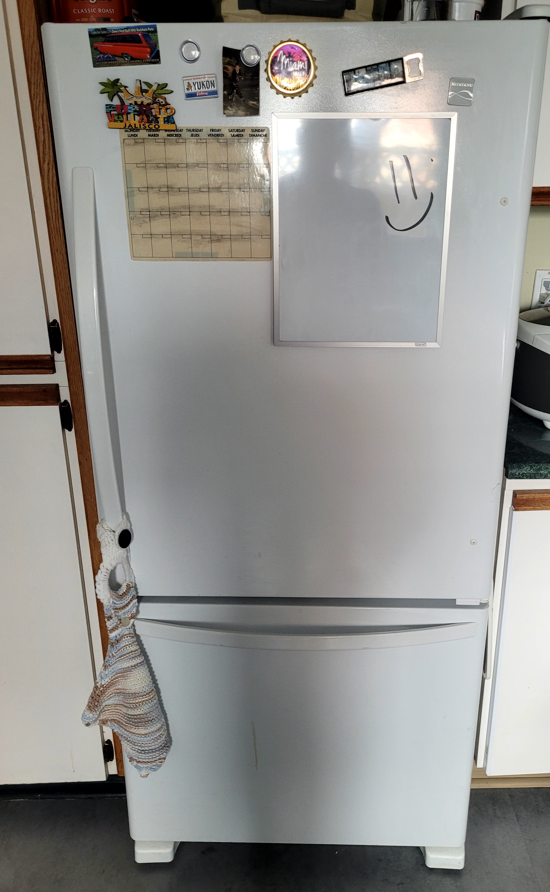
This front loading fridge is very typical in Canada of the United States. Very convenient and holds lots of food. Has a fridge area, has a freezer area. Cools very well.
But
It requires a lot of power. Costs a lot of money. Is very large and bulky.
The simple fact is that every time you open the door on this device all the cool air comes right on out and goes to the floor. Great for cooling your toes but once you close the door the device has to start drawing power to replace all that cold air that was lost.
Very Inefficient and easily costs $1000 or more.
Small Front loading "Dorm Style" Fridge (mini refrigerator)
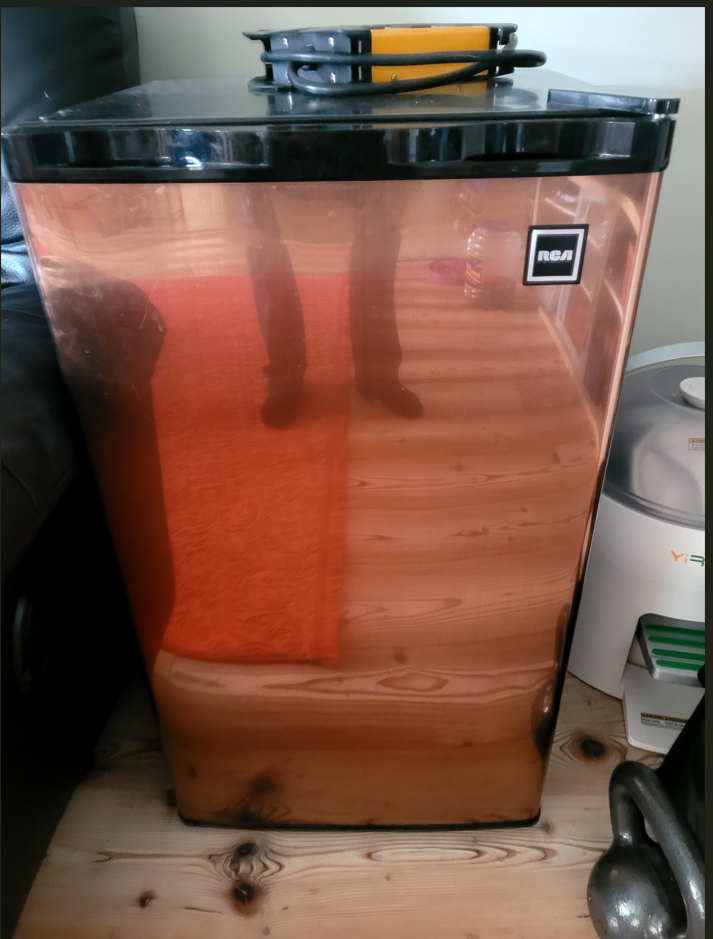
With the big fridges being so commonplace that everyone has them it is natural that people look to have that convenience in other rooms. Bedrooms, dorm rooms, TV rooms and so forth. Which of course brought about the availability of mini fridges.
These little models use less electricity, have small freezers, less space and a much lower price tag. Often in the $100 to $200 range. However, they still suffer from the same front loader problem. Every time they get opened they need to start cooling again.
they are also very inefficient although they are actually fairly affordable.
Top loading mid size fridge / freezer
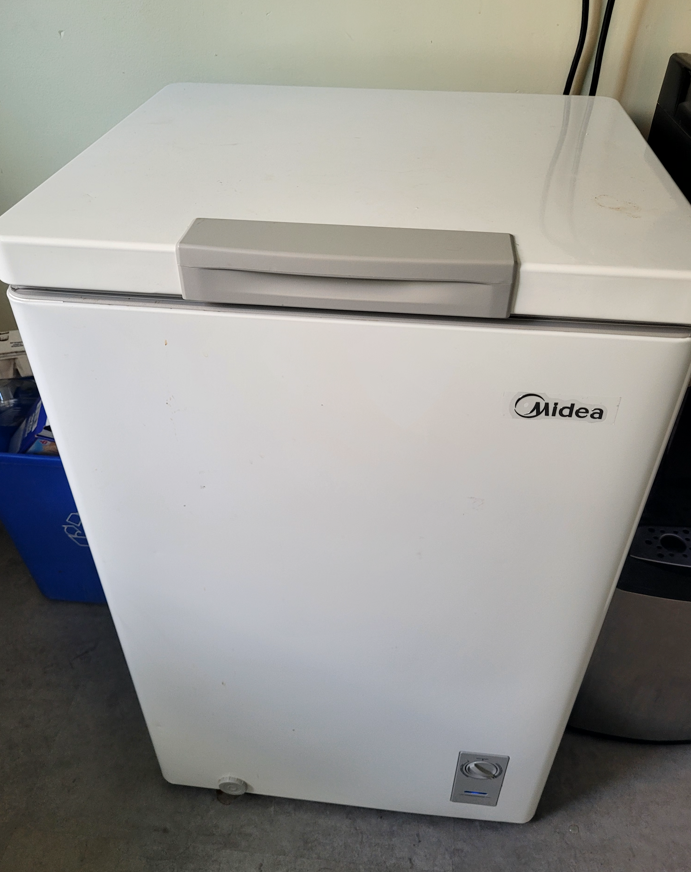
Now I really like these fridges. Usually when you see them in North America they are being used as freezers. However, this model can be either a fridge or a freezer depending on how low the temperature is set.
As you can see food is loaded from the top. If you open the door to get out some food the cold air stays in the fridge!. Very little cooling is lost when opened so they are much more efficient. Honestly they can be had for a fairly reasonable price tag. This model cost me very close to $200 HBD.
Top loading "tiny" fridge / freezer

Now I've fallen in love with this tiny little fridge. As you can see it is also a top loading model. It is very efficient at keeping things cold and uses very little electricity to get and keep things cold. It has very limited holding capacity and a moderately expensive price tag $300. Then again it is also more versatile as it can run on home AC current OR it can run on 12V current in a car, boat, or RV.
Criteria for choosing
Power Consumption
When off-grid or in a country with unreliable power it is very important to consider how much power the fridge will use. Large power consumption means having a large battery bank in case of power outage. Large power banks are expensive and bulky. When I'm testing these fridges the size of power bank will be a major consideration for me. I understand Nigeria doesn't have reliable power and off-grid has limited power so I'll be using these fridges on power banks to find the best combination.
Cooling abililty
If the device won't get cold enough then it is not useful. Any device must be able to cool food effectively and keep it cold. Being able to accurately choose your cool level between cool, cold, and frozen solid is an added bonus.
Insulation
This is indirectly related to cooling ability. A well insulated fridge will keep things colder for a longer time without using electricity. Any good fridge will have excellent insulation.
Size
Another important factor. If it doesn't hold what you need it to hold then the fridge is useless. Larger is better for most people however, I've seen the sizes of some See me / See you rooms in Nigeria and they are often very small. Large enough to hold what you need and small enough to fit in your room are both important considerations.
Cost
Hate to say it but sometimes its important to look at the price. Paying a small amount for something that doesn't work is money wasted. Having a large price tag without enough money means the item can be purchased. In the end price will certainly play a part in what gets purchased.
What did I try?
I tried 4 different fridges and 4 different power banks. Not every combination was useful so I'll start with a quick list of what I tried and why many didn't go very far.
- Full Sized Fridge and Power Bank.
A full sized fridge uses 200W when running and a much larger surge power when the compressor starts. As such it was only able to run when powered by a full sized power bank (Bluetti). A $1000+ fridge with a $1700+ power bank made for a powerful and convenient solution. However, with that price tag I'll leave that as "probably too expensive for the average person in developing nation and too much power usage for off-grid/solar usage. Going further I won't be using the Bluetti power bank as its too expensive for most people on a tight budget.
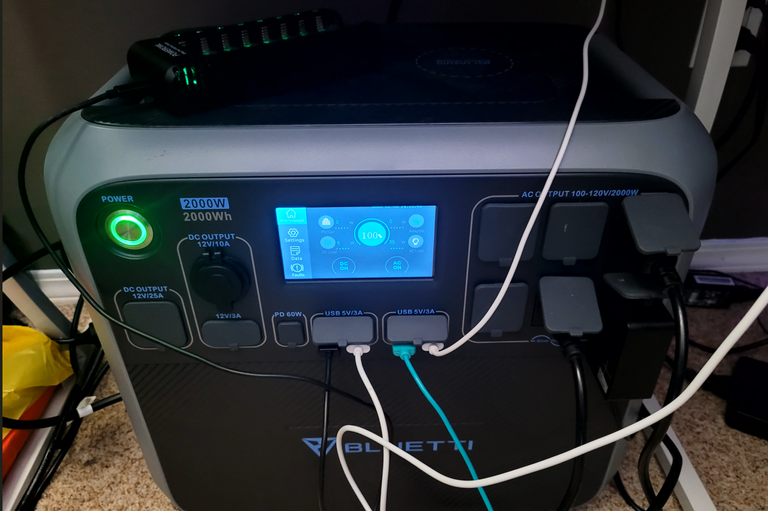
- "Dorm Style" fridge.
As the least expensive fridge at $100HBD I thought it should get a trial. I mean its cheap as far as fridges to and actually works quite well. However my Rocksolar and Pafish 100W power banks would not run it. My CTECHI 200W power bank would run it but not for very long.
While the fridge is rated to use 80W running its surge power to get the compressor going was more than the small power banks could provide.
- Top Loading Mid Sized Fridge.
It is rated to use about 120W when working with a surge load to start it. Again the small 100W banks were unable to power it. The larger CTECHI unit could work it and for almost 4 hours. There might be some possibility to make a combination with this fridge unit but I decided it wouldn't be the best choice.
- Top Loading mini fridge.
I really thought this one was going to be a winner with the Rocksolar or Pafish battery banks. Certainly with the CTECHI power bank. This fridge only uses 20W of power while running (surge to start as always) which meant that there was a good chance it would run with even the smaller power banks. There was some success and look below for the first set of results.
The results
Tiny Fridge with Rocksolar 100
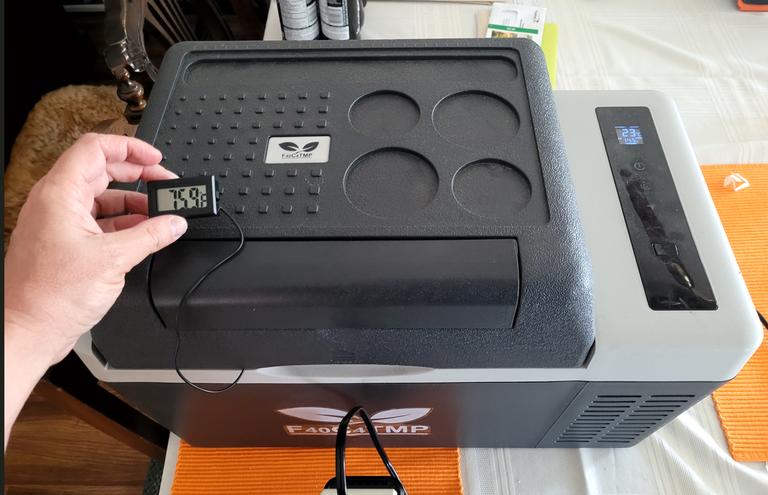
I started this unit at 23C and let it run. My thought was that the 80Wh battery could run the fridge for 4hrs (20W/hr). How could would it get? Would it be able to freeze 1L of water? How long would the water be frozen?
The fridge did work quite well with the tiny battery bank. It happily kept the compressor going to get the fridge temperature from 22C down to 0C with some drinks inside.
Unfortunately it only ran for 75 minutes. Not the 240 minutes I hoped for. I was excited to see how cold the drinks got and unfortunately they didn't get that cold. It seems that even if the fridge if 0C the drinks take time to cool down. Guess heat transfer has something to do with that.
Overall: FAIL. Fridge got cold but drinks did not
Tiny Fridge with Pafish 100
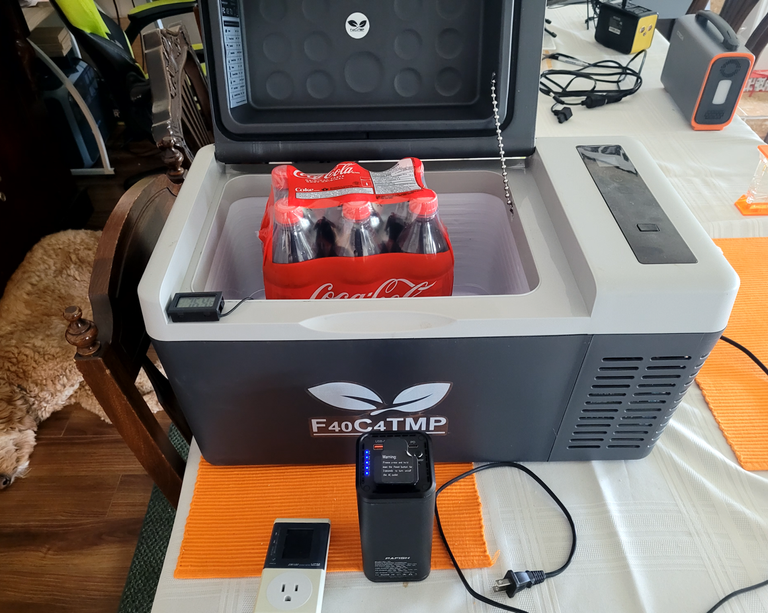
With the results from the Rocksolar unit I decreased my expectations for the Pafish unit. It had 100Wh of electricity storage so I expected it to run longer. However, would it be able to give me cold drinks?
Again I started at 22C and let it run until the battery died. Theoretical maximum would be 5hrs. I checked the temperature every 15 minutes (roughly) and after 105minutes the temperature dropped from 22C down to -3C. I was again excited to try the drinks inside but again was disappointed because while the fridge was cold the drinks didn't cool fast enough.
Overall: FAIL. Fridge got cold but drinks did not
Tiny Fridge with CTECHI 300
By the time I was running this combination I didn't know what to expect. With 200Wh of battery power and a power output of up to 300W I was certain that the fridge would run. Of course it did. This time for closer to 3 hours of constant cooling. It was interesting to note that the fridge temperature still only got to -4C after 3 hours.
I had actually expected the temperature to dip lower than -4C after all it was cooling for over an hour longer than the Pafish combination. However it seems that at a certain temperature the heat transfer from the liquid in the drink counteracted any further drop in the fridge temperature.
Overall: Limited success. This time the drinks were cool (although not frozen) after 3 hours
Why did I say limited success?
Simple. Using a $200 battery bank and a $300 fridge to get a few cold drinks seems of limited value. Especially useless because after 3 hours there was no more power which means if you wanted to leave food in it overnight it would cool...but then return right back to room temperature by the morning.
How do I know this? Temperature in the fridge went from Freezing (or lower) to 8C after just over an hour.
Another alternative?
Obviously the approach of using stored power in a battery bank wasn't going to be enough for useful cooling power. I needed another idea. Which leads me to my next power alternative.
My rationale was this:
If you have a solar panel then during the day you can have constant cooling. Then if the inside is cold enough it can stay cool overnight then repeat the process the next day.
Test ONE: Pafish bank connected to 30W USB-C charger while cooling
I thought if the fridge uses 20W and the USB provides 30W then I could run the fridge constantly from a USB-C solar panel for an entire day and get good cooling.
So I tried it out
....and.
....the unit will charge or discharge but won't do both at the same time
The moment I hooked up the USB-C charger the AC output cut off.
RESULT: The Pafish would be useless for solar connection and cooling
Test TWO: Rocksolar bank connected to 29W AC power.
I didn't have a 30W solar panel but thought I would just connect the charger to the bank for 6 hours to simulate being hooked up to a solar panel. Again, my thought was 20W to the fridge and 29W input ...result I'll cool continuously for 6 hours then just draw a small amount of power from the bank to keep the fridge cool.
This time it WILL charge and discharge at the same time. However, it only ran for 4 hours and after that the battery was fully discharged even though it should have been getting enough current to keep fully charged.
RESULT: The Rocksolar would be able to cool drinks but not run long enough to provide daily refrigeration
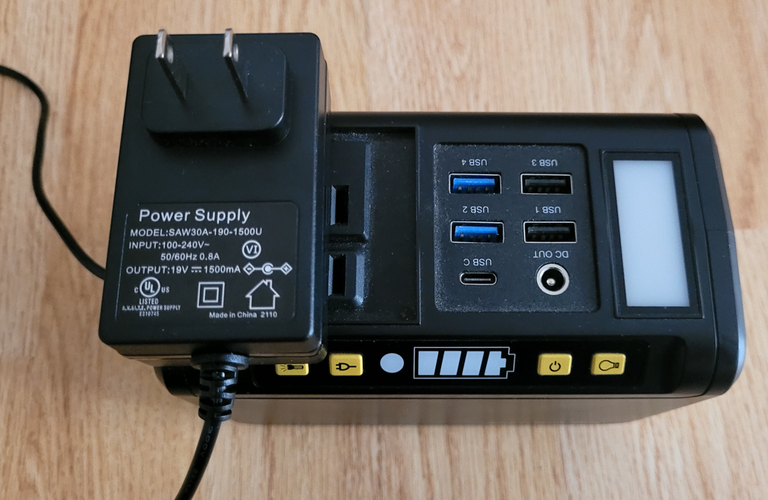
Side note: I was really confused as to why I was adding 29W but it didn't have enough power to keep up. I looked a little further and this is what I found out. It was a 29W power supply that provided 19V @ 1.5A. Now that's great but the batteries it is charging are (3.7V * 4battery=14.8V). That means that 1.5A @ 14.8V or 21W is going into the battery. But battery charging is only about 80% efficient so 17W going into the battery. 20W coming out. Result: Battery ends up dead. More coming out that going in. Also with all the lost wattage the battery got pretty hot.
Test THREE: CTECHI power bank connected to 40W charger
Again I used the 40W charger from the bank to simulate a solar panel. This time the results were different from that of the Rocksolar unit. It seems that the CTECHI unit uses MPPT charging as opposed to dumb the more basic charging circuit technology in the Rocksolar. MPPT is a system where a circuit adjusts the charging voltage to provide maximum current so that if 40W are given 40W are put into the battery (minus inefficiencies). This results in much more efficient charging and less excess heat while charging.
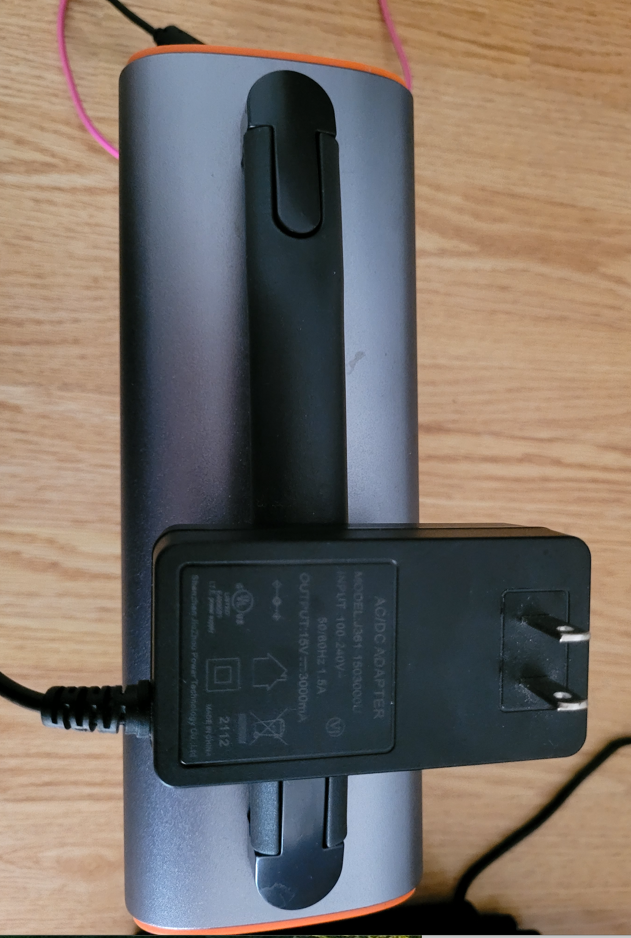
This time the results were much better. After 6 hours the CTECHI unit was still happily powering the fridge and temperature got a LOT colder. It got to -17C. However, even at -17C for 6 hours I was surprised that the liquid inside had not turned to ice. Well, some of the liquid had turned to ice but it wasn't solid brick of ice.
Then I watched how quickly the temperature returned to room temperature and before 8 hours was out everything was warm again.
RESULT: It worked very well to keep things cool throughout the day while the "sun" was out but would not provide useful 24hrs worth of cooling.
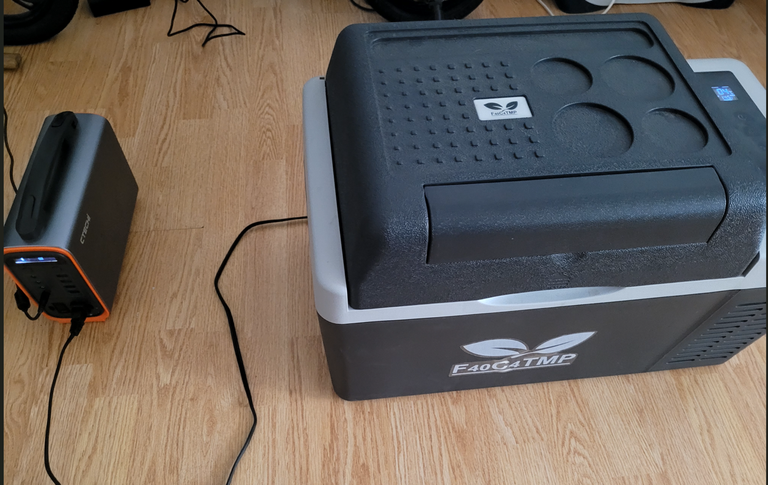
Going Old School
By this time I was getting a little frustrated trying to figure out something that could provide useful cooling on a limited budget with limited access to reliable electricity.
I used a little bit of thought, a little "old school" know how and came up with something that could actually make a useful alternative.
An Old School Icebox.
What I did was took a 4L milk jug and filled it with water. I put that in the fridge and put it on coldest setting (-22C) it took almost 18 hours but after that time the water was fully frozen.
After that I put the fridge on the charger for 6hrs on and 18hrs off. I let it go for a week and here are the result:
Every day after 6hrs with the power on the temperature would reach -22C. After that time the big block of ice in the milk jug would ensure that the temperature of the box would never get any higher than 4C.
By using a combination of cooling power from the "sun" while it was available during the day AND using the cooling power of a big block of ice when power wasn't available I was able to make sure that the fridge stayed cold enough to be useful for at least a week.
Now by the end of the week the ice block wasn't "fully frozen" like it was at the beginning of the week. However it was at least 50% frozen meaning I would likely be able to continue for at least 2 or more weeks before the fridge wouldn't be cold enough to perform its duty.
The final verdict
I hoped that I could get a power bank to be able to run a fridge all by itself. Nope that just wasn't going to happen.
I hoped that a small power bank would be up to the job of powering a very low power fridge. No that wasn't going to work either.
In the end I did get a fairly small power bank to power a tiny fridge on a fairly long term basis....with a little help from old school know how.
If I was in Nigeria and had a lot of sunny days to add cooling from solar. Add in a few hours of power from the electrical grid every now and then I would bet that the combination would mean that the fridge would be working to keep things cold all day, every day.
Sure it has limited space. Sure its not perfect. However, for a $100 Solar Panel, a $200 power bank, a $300 fridge and a cheap container for water its a 24hr a day solution for cooling whether off grid or on a limited power situation.
So, 3 weeks of trial and error. 3 weeks of having my wife wonder what on earth I'm doing with soda bottles, milk bottles, power banks and fridges....I finally have some data on how I'd keep things cool if I was in Nigeria (or the Philippines ...where I hope to retire someday 😉)
Thanks for reading
And as always, I love getting comments
